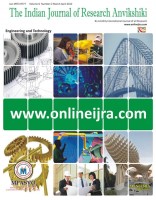Research Paper

An Analysis of Synchronous Coherent Optical Code Division Multiple Access (OCDMA) Network
Author: *Ram Gopal Sonker, **Anand Gandhi Patel, ***Ram Ajor Yadav
*HOD, Department of Electronics & Communication Engineering, SHEAT College of Engineering, Varanasi
and Assistant Center Controller (ACS) through GBTU Lucknow ( mail- id rgsindiaglobal.zone@gmail.com )
**Anand Gandhi Patel
**Assistant Professor, Department Electronics & Communication Engineering, SHEAT College of Engineering,
Varanasi (mail- id engganand.gandhi@gmail.com )
***Ram Ajor Yadav
***Examination Controller, D
Download PDF
Abstract
An Analysis of a Synchronous Coherent Optical Code Division Multiple Access Networks (OCDMA) is accomplished by analyzing various CDMA code sequences. The entire essential signal processing which include, switching, add/drop, multiplexing/ de-multiplexing, amplification and synchronization are performed in the optical domain. Among the many multi-access techniques that have been introduced, optical code division multiple access is believed to be the most robust as the speed and scale of information processing elements grow and the number of nodes reach the order of hundreds to thousands. Recent advances in optical devices and their ubiquitous use in the future all optical networks, in particular in Optical Code Division Multiple Access (OCDMA), have been the main thrust behind a vast number of research activities. These could prove to be essential for successful all OCDMA system, and one such application is optical synchronization, which will be dealt later in detail in forthcoming chapters. These are modified and implemented for all optical networks, in OCDMA systems. These include m-sequences, Gold codes, Prime sequences and Modified prime code sequences. A simulation model of an OCDMA network for the analysis and performance of these sequences is developed and analyzed. From these studies it has been shown that for a large number of simultaneous users in the network, Modified Prime codes give the best system performance. Also, for a coherent system, bipolar codes have a significantly better performance. The hardware technology used in the implementation of an OCDMA system is studied. It includes the transmitter structures and receivers with various modifications that can be implemented. The synchronous and asynchronous techniques, coherent and non-coherent with electrical or optical processing are examined for CDMA.